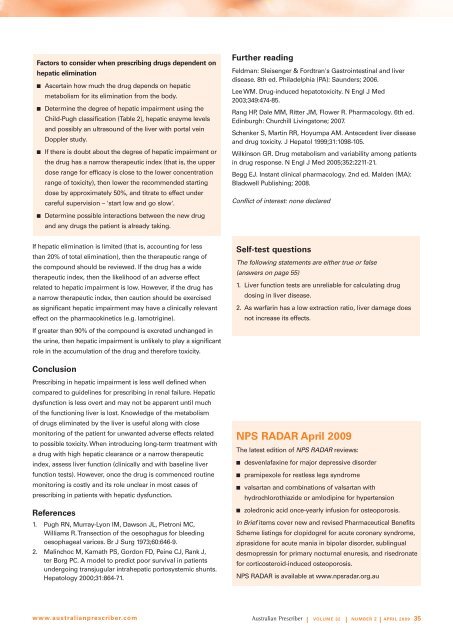Prescribing in liver disease - Australian Prescriber
Prescribing in liver disease - Australian Prescriber
Prescribing in liver disease - Australian Prescriber
You also want an ePaper? Increase the reach of your titles
YUMPU automatically turns print PDFs into web optimized ePapers that Google loves.
Factors to consider when prescrib<strong>in</strong>g drugs dependent on<br />
hepatic elim<strong>in</strong>ation<br />
n Ascerta<strong>in</strong> how much the drug depends on hepatic<br />
metabolism for its elim<strong>in</strong>ation from the body.<br />
n Determ<strong>in</strong>e the degree of hepatic impairment us<strong>in</strong>g the<br />
Child-Pugh classification (Table 2), hepatic enzyme levels<br />
and possibly an ultrasound of the <strong>liver</strong> with portal ve<strong>in</strong><br />
Doppler study.<br />
n If there is doubt about the degree of hepatic impairment or<br />
the drug has a narrow therapeutic <strong>in</strong>dex (that is, the upper<br />
dose range for efficacy is close to the lower concentration<br />
range of toxicity), then lower the recommended start<strong>in</strong>g<br />
dose by approximately 50%, and titrate to effect under<br />
careful supervision – 'start low and go slow'.<br />
Further read<strong>in</strong>g<br />
Feldman: Sleisenger & Fordtran's Gastro<strong>in</strong>test<strong>in</strong>al and <strong>liver</strong><br />
<strong>disease</strong>. 8th ed. Philadelphia (PA): Saunders; 2006.<br />
Lee WM. Drug-<strong>in</strong>duced hepatotoxicity. N Engl J Med<br />
2003;349:474-85.<br />
Rang HP, Dale MM, Ritter JM, Flower R. Pharmacology. 6th ed.<br />
Ed<strong>in</strong>burgh: Churchill Liv<strong>in</strong>gstone; 2007.<br />
Schenker S, Mart<strong>in</strong> RR, Hoyumpa AM. Antecedent <strong>liver</strong> <strong>disease</strong><br />
and drug toxicity. J Hepatol 1999;31:1098-105.<br />
Wilk<strong>in</strong>son GR. Drug metabolism and variability among patients<br />
<strong>in</strong> drug response. N Engl J Med 2005;352:2211-21.<br />
Begg EJ. Instant cl<strong>in</strong>ical pharmacology. 2nd ed. Malden (MA):<br />
Blackwell Publish<strong>in</strong>g; 2008.<br />
Conflict of <strong>in</strong>terest: none declared<br />
n Determ<strong>in</strong>e possible <strong>in</strong>teractions between the new drug<br />
and any drugs the patient is already tak<strong>in</strong>g.<br />
If hepatic elim<strong>in</strong>ation is limited (that is, account<strong>in</strong>g for less<br />
than 20% of total elim<strong>in</strong>ation), then the therapeutic range of<br />
the compound should be reviewed. If the drug has a wide<br />
therapeutic <strong>in</strong>dex, then the likelihood of an adverse effect<br />
related to hepatic impairment is low. However, if the drug has<br />
a narrow therapeutic <strong>in</strong>dex, then caution should be exercised<br />
as significant hepatic impairment may have a cl<strong>in</strong>ically relevant<br />
effect on the pharmacok<strong>in</strong>etics (e.g. lamotrig<strong>in</strong>e).<br />
Self-test questions<br />
The follow<strong>in</strong>g statements are either true or false<br />
(answers on page 55)<br />
1. Liver function tests are unreliable for calculat<strong>in</strong>g drug<br />
dos<strong>in</strong>g <strong>in</strong> <strong>liver</strong> <strong>disease</strong>.<br />
2. As warfar<strong>in</strong> has a low extraction ratio, <strong>liver</strong> damage does<br />
not <strong>in</strong>crease its effects.<br />
If greater than 90% of the compound is excreted unchanged <strong>in</strong><br />
the ur<strong>in</strong>e, then hepatic impairment is unlikely to play a significant<br />
role <strong>in</strong> the accumulation of the drug and therefore toxicity.<br />
Conclusion<br />
<strong>Prescrib<strong>in</strong>g</strong> <strong>in</strong> hepatic impairment is less well def<strong>in</strong>ed when<br />
compared to guidel<strong>in</strong>es for prescrib<strong>in</strong>g <strong>in</strong> renal failure. Hepatic<br />
dysfunction is less overt and may not be apparent until much<br />
of the function<strong>in</strong>g <strong>liver</strong> is lost. Knowledge of the metabolism<br />
of drugs elim<strong>in</strong>ated by the <strong>liver</strong> is useful along with close<br />
monitor<strong>in</strong>g of the patient for unwanted adverse effects related<br />
to possible toxicity. When <strong>in</strong>troduc<strong>in</strong>g long-term treatment with<br />
a drug with high hepatic clearance or a narrow therapeutic<br />
<strong>in</strong>dex, assess <strong>liver</strong> function (cl<strong>in</strong>ically and with basel<strong>in</strong>e <strong>liver</strong><br />
function tests). However, once the drug is commenced rout<strong>in</strong>e<br />
monitor<strong>in</strong>g is costly and its role unclear <strong>in</strong> most cases of<br />
prescrib<strong>in</strong>g <strong>in</strong> patients with hepatic dysfunction.<br />
References<br />
1. Pugh RN, Murray-Lyon IM, Dawson JL, Pietroni MC,<br />
Williams R. Transection of the oesophagus for bleed<strong>in</strong>g<br />
oesophageal varices. Br J Surg 1973;60:646-9.<br />
2. Mal<strong>in</strong>choc M, Kamath PS, Gordon FD, Pe<strong>in</strong>e CJ, Rank J,<br />
ter Borg PC. A model to predict poor survival <strong>in</strong> patients<br />
undergo<strong>in</strong>g transjugular <strong>in</strong>trahepatic portosystemic shunts.<br />
Hepatology 2000;31:864-71.<br />
NPS RADAR April 2009<br />
The latest edition of NPS RADAR reviews:<br />
n desvenlafax<strong>in</strong>e for major depressive disorder<br />
n pramipexole for restless legs syndrome<br />
n valsartan and comb<strong>in</strong>ations of valsartan with<br />
hydrochlorothiazide or amlodip<strong>in</strong>e for hypertension<br />
n zoledronic acid once-yearly <strong>in</strong>fusion for osteoporosis.<br />
In Brief items cover new and revised Pharmaceutical Benefits<br />
Scheme list<strong>in</strong>gs for clopidogrel for acute coronary syndrome,<br />
ziprasidone for acute mania <strong>in</strong> bipolar disorder, subl<strong>in</strong>gual<br />
desmopress<strong>in</strong> for primary nocturnal enuresis, and risedronate<br />
for corticosteroid-<strong>in</strong>duced osteoporosis.<br />
NPS RADAR is available at www.npsradar.org.au<br />
www.australianprescriber.com<br />
| Volume 32 | NUMBER 2 | APRIL 2009 35
















